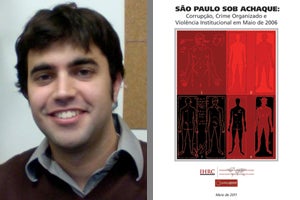
Five years ago, a series of coordinated uprisings in 74 detention centers and attacks on police stations and public buildings left 43 state officials and hundreds of civilians dead and brought South America’s largest city and financial capital to a standstill. São Paulo streets were deserted as residents stayed at home in fear. After the violence—which was coordinated by the organized crime syndicate the “First Command of the Capital” (Primeiro Comando da Capital, or “PCC” by its Portuguese initials)—stopped, police killed scores of civilians in a wave of reprisal attacks, targeting those they suspected of having criminal backgrounds. Evidence in 122 killings contains signs that police committed extrajudicial executions.
Now, Harvard Law School’s International Human Rights Clinic and the leading Brazilian human rights group Justiça Global have released a comprehensive study of the May 2006 attacks. The Report, “São Paulo sob Achaque: Corrupção Crime Organizado e Violência Institutional em Maio de 2006,” seeks to answer several questions essential to public security in Brazil: What led to the attacks? Why were state authorities unable or unwilling to prevent them? Why and how did the police lash out violently in revenge killings? Why have the crimes committed by the state not been investigated, and in many cases, apparently covered up?
The result of five years of investigation—including hundreds of interviews; scores of on-site visits to jails, prisons, and communities affected by violence; meetings with a broad range of authorities; and a review of thousands of pages of documents, police reports, and judicial records—sheds new light on the May 2006 attacks. “Official corruption, tragically, was a driving force behind the May attacks. PCC leaders—new information in the study confirms—coordinated their assault in large part as a response to a series of organized shakedowns by the police,” said Fernando Delgado, a Fellow at Harvard Law School and the principal author of the report. “The evidence indicates that a year prior to the attacks, police were using wiretaps, kidnapping, and other abuse of family members of gang leaders to extract bribes. The PCC decided to retaliate brutally and brought the city to a halt.”
The report outlines the formation of the PCC by prisoners outraged by massacres in detention centers (including the killing of 18 at the 42nd police district in 1989, and of 111 in the Carandiru massacre of 1992), horrendous conditions of detention and torture, and its growth, fostered by official corruption at the highest levels in São Paulo state.
The study examines the state’s failure to alert its police and other officials of the impending attacks, even though information now available demonstrates that high level authorities were on notice of the very real threat of coordinated attacks in May 2006 by the PCC. It also reveals a staggering level of police violence. The Harvard and Justiça Global report compiles evidence indicating that police executed 51 in alleged shootouts and killed another 71 while acting in ‘death squads.’ Equally worrisome, the report concludes, is a clear state bias in the investigation of murders. When state agents were victims, the elite police investigation team Department of Homicides and Protection of the Person (Departamento de Homicídios e de Proteção à Pessoa, DHPP) identified the killers in 12 of 14 cases; when police were suspected, the DHPP identified the killer in just 4 of 34 cases.
The report also found that the state made no significant progress in reforming the prison system. The 74 detention centers that rioted in May 2006 are currently more overcrowded than on the eve of the attacks, in large part because of continuing failures within the judicial system, in which, for example, pre-trial detainees constitute some 30% of those incarcerated.
“The report is a thorough study and demonstrates conclusively the central role of state violence and corruption both in the initial attacks and the police response,” said Sandra Carvalho, director of Justiça Global and one of the coordinators of the research project. “It also demonstrates that São Paulo continues to be as exposed to another series of May attacks as ever.”